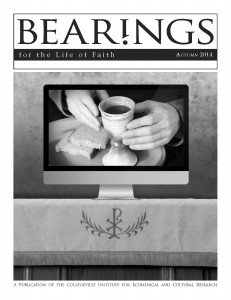 Thanksgiving Sunday, 1974. We arrived at worship expecting to find the sanctuary awash in squash, mason jars of beets and peaches, and sheaves of wheat. But, there – where the potatoes and beans should have been – was a heart-monitoring device, a portable x-ray machine, a microwave oven, a push-button speaker telephone, a “pocket” calculator, and an IBM card sorter. We gave thanks for the technological advances that supported the local economy, fueled imaginations and cured illnesses previously considered fatal. Some members shook their heads in disgust. Others smiled and nodded.
Thanksgiving Sunday, 1974. We arrived at worship expecting to find the sanctuary awash in squash, mason jars of beets and peaches, and sheaves of wheat. But, there – where the potatoes and beans should have been – was a heart-monitoring device, a portable x-ray machine, a microwave oven, a push-button speaker telephone, a “pocket” calculator, and an IBM card sorter. We gave thanks for the technological advances that supported the local economy, fueled imaginations and cured illnesses previously considered fatal. Some members shook their heads in disgust. Others smiled and nodded.
Remember, in 1974 a computer relied on cardboard key-punch cards. Eight-track recording was state of the art. Tiny cars on Mars, MRIs, social media, artificial intelligence and Sunday morning PowerPoint belonged to the futuristic world of The Jetsons.
Forty years on we haven’t lost our gratitude for, and suspicion of, the technological advances that shape our days. We generally think of technology as “neutral”; the tool itself is neither good nor bad. What determines the value of a technology is how it is applied – “Guns don’t kill people. People kill people.”
All technology inherently has both good and bad qualities.
But technology, and here I concur with the philosopher and Christian anarchist Jacques Ellul, is never neutral. All technology inherently has both good and bad qualities. Its relative goodness or badness cannot be assessed simply by how it is used. Guns are used to keep the peace and they are used in school massacres. New medical technologies save lives and cut the poor off from medical care. Video games occupy children on long car rides and are associated with childhood obesity and negative impacts on cognitive development. The positive and negative qualities of all technologies are inseparable.
This distinction – between having both good and bad qualities verses being neutral – may seem like splitting hairs. However, in our unexamined confidence that technological and scientific advancements are neutral, we fail to notice that technology’s benefits “….are multiplied a hundred fold and the negative aspects are radically concealed” (Ellul, The Technological Bluff).
When we talk about new technologies in the church we are mostly talking about communication technology – email, websites, tweets, PowerPoint, live streaming and so on.
Technological advances, for better or worse, supplant existing practices and culture.
Churches have always employed new technologies – stained glass, printing, pipe organs, and steno-copied bulletins are obvious examples. Each of these irrevocably changed the church. Alfred North Whitehead put it even more strongly. We’re not talking simply about change, but about destruction. “The major advances in civilizations are processes that all but wreck the societies in which they occur,” Whitehead wrote.Technological advances, for better or worse, supplant existing practices and culture.
I arrived late to a meeting with senior denominational church leaders. My colleagues’ heads were already bowed. So I stopped in the boardroom doorway to wait for them to finish. That is until one colleague, head still bowed, asked another, “Did you get the request from the Globe?” They were not bowing in prayer but into their laps and BlackBerrys and to the barrage of emails. Social media connects us to the world and it can alienate us from the person across the table, or next door.
John O’Donohue, poet, author, and priest is especially critical in Anam Cara: A Book of Celtic Wisdom:
Technology and media are not uniting the world. They pretend to provide a world that is internetted, but in reality, all they deliver is a simulated world of shadows. … They make our human world more anonymous, more lonely.
My congregation appreciates the rich visual images, the immediate references to popular culture and world events, and singing with our heads up instead of into the pages of a book that PowerPoint affords us. That said, with the screen at the front of the sanctuary, worshiping in a circle where we can look into one another’s eyes is problematic. I feel drawn deeper into intimacy with God and the world through the projected images but perhaps not so much with the person sitting next to me. The benefits and losses are inseparable.
Every innovation in technology comes with both blessing and curse. Their blessings are well known and celebrated. Within the church new technologies support lively worship, staying in touch with one another, and communicating our message to the world. Grace and human intimacy and community can be experienced through social networks; but it is grace and intimacy and community once removed.
In sum, recent technological advances have not transformed the human heart. While technology presses forward, moral judgment and compassion have not kept pace. This is an important dimension of the challenge of technology left to us, particularly those of us in churches. While employing and enjoying new technologies, we must also confront and mitigate their inherent challenges.
 If you’re interested in reading more about the relationship between digital communication and the religious life, check out the Autumn 2014 issue of Bearings Magazine.
If you’re interested in reading more about the relationship between digital communication and the religious life, check out the Autumn 2014 issue of Bearings Magazine.
Image: IBM 26 on/off switch by Marcin Wichary on Flickr via a Creative Commons License.
Like this post? Subscribe to have new posts sent to you by email the same day they are posted.



Leave a Reply